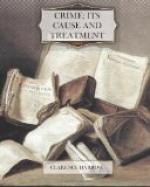The criminal, it must be remembered, is almost always poor. He has a mother, brothers and sisters, wife or children, dependent for support to a large extent, upon his casual earnings. He is placed in jail or the penitentiary and the family must make new adjustments to life. The mother or wife may go to work at hard labor for a small return; the children may be taken out of school and sent to stores or factories, be condemned to lives of drudgery that will often lead to crime. The family may be broken up and scattered through institutions and the poorest shelters. A complete transformation for the worse almost always comes over the home. It is safe to say that at least three or four are closely touched by the misfortune of every one. These lives must be readjusted, and the chances are that the new adjustments will not be equal to the old, if for nothing else than because the conviction is a serious handicap in their struggles. Let anyone go to a city jail on a visiting day and see the old mothers, the stunned and weeping wives, the little children, down to babes in arms, who crowd around the corridors to get a look at the man behind the bars. To them at least he is a human being with feelings and affections, with wants and needs. All of these can recount his many good qualities which the world cannot see or know. Their first step is to borrow or to sell what they can to provide means for his defense. Everything else is cast aside. Day after day they visit the jail and the lawyer, contriving means to save liberty or life. When the trial comes, they watch through its maze in a dazed, bewildered way. They know that the man they love is not the one who is painted in the court room, and at least to them he is not. If he is convicted and goes to prison for a term of years, then month by month the faithful family goes to see him for an hour in the prison, visiting across the table in open view of guards and others as unfortunate as they. The family follows all sorts of advice and directions and seeks out many hopeless clews for men of influence and position who can unlock prison doors. The weeks run into months and the months into years, and still many of them keep up their hopeless vigil; some are driven to drudgery, some to crime, some to destruction for the man whom the state has punished that society may be improved. It is safe to say that the state ruins at least one other life for every victim of the prison.
No provision is made for the dependent families of the wretched man. Ruthlessly society sends the man to prison and sees the daughter leave school, a mere child, and go to work. What becomes of her it does not know or care. It seems not to know that she exists. The state sees the convict’s boy working at casual tasks and growing up on the streets, while his father is paying the penalty of his act. He may on this account follow his father to jail; it is not society’s concern.
Assuming that an offender must be confined for the protection of society, as some no doubt must be, still the effect on the family and how to prevent its destruction should be among the first concerns in the disposition of the case.




